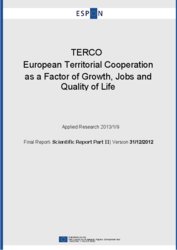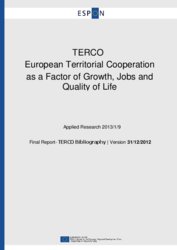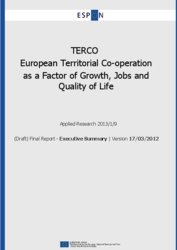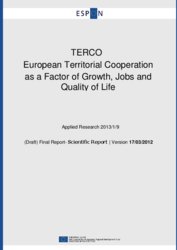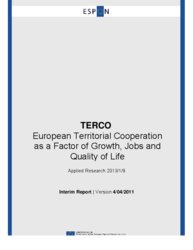TERCO - European Territorial Cooperation as a Factor of Growth, Jobs and Quality of Life
Theme
Territorial cooperation in transnational areas and across internal/external borders
Thematic scope
Territorial cooperation is seen as one of the most important factors contributing to innovation which is key in the achievement of sustainable growth and jobs. European territorial cooperation facilitates the exchange between people and regions on experience and best practice in regional policy, irrespective of existing borders.
Experiences with territorial cooperation have been gathered in different European areas and with different structures. One of the aims of the current EU programming period 2007-2013 is to reinforce added value through cooperation across borders, transnationally as well as interregionally. Regions and cities from different EU Member States are encouraged to work together to find common solutions in different fields. The Green Paper on Territorial Cohesion of the European Commission also adresses territorial cooperation and attaches great importance to it in the framework of European territorial development and in the “long-term and sustainable growth performance of the EU as a whole”.
Future considerations concerning the strengthening of territorial cooperation may benefit from facts concerning potential drivers for cooperation, determinants and governance structures. These could spark further interest of regions, cities and countries in entering into cooperation arrangements. More evidence in this field can also serve as support in defining future EU Structural Funds contribution to territorial cooperation areas.
Please read more about the main research areas and main results envisaged on the next page.
Lead Partner
EUROREG Centrum Europejskich Studiów Regionalnych i Lokalnych, Uniwersytet Warszawski, Poland
Detailed information on the contracted project team can be found under Transnational Project Groups.
Sounding Board
Philippe Doucet, France
Joaquin Farinos Dasi, Spain
Budget: € 849 710,00
Project’s lifetime: February 2010 – March 2013
Delivery of Reports
Inception Report: 2 September 2010
Interim Report: 2 March 2011
Draft Final Report: 2 March 2012
Final Report: 1 July 2012
Publishing
Reports will be published once they are approved by the ESPON Monitoring Committee
More information
Please contact the Project Expert at the ESPON Coordination Unit:
Marjan VAN HERWIJNEN, e-mail: marjan.vanherwijnen@espon.eu
Main research areas
- Assessment of the adequacy of existing territorial cooperation areas for meeting current challenges of territorial development (e.g. global competitiveness, cohesion, climate change, demographic change) and proposal of potentially more meaningful new cooperation areas throughout Europe.
- Analysis of the appropriate scale for different domains of transnational territorial cooperation.
- Identification of the most favourable framework conditions and good governance models for territorial cooperation to be realised and to succeed.
- Study of the role of infrastructure investment in cooperation programmes
- Implementation of case studies to analyse in greater detail how mechanisms for decision making are established in different territorial cooperation areas and to assess experiences made as well as the potential transferability of cases of good practice.
Main results envisaged
- Data on (common) characteristics and critical mass for transnational and cross-border cooperation areas.
- Indicators offering additional information on the different types of European cooperation areas and new complex indicators, revealing these areas’ development opportunities, their socio-economic situation as well as their competitiveness.
- Typologies of transnational and cross-border cooperation areas classified by territorial evidence based characteristics, strengths, weaknesses, potentials and challenges.
- European maps revealing (1) a typology of different (possible) cooperation areas, (2) the current territorial state per possible cooperation area (characteristics, strengths, and weaknesses), (3) territorial potentials and challenges per possible cooperation area.



